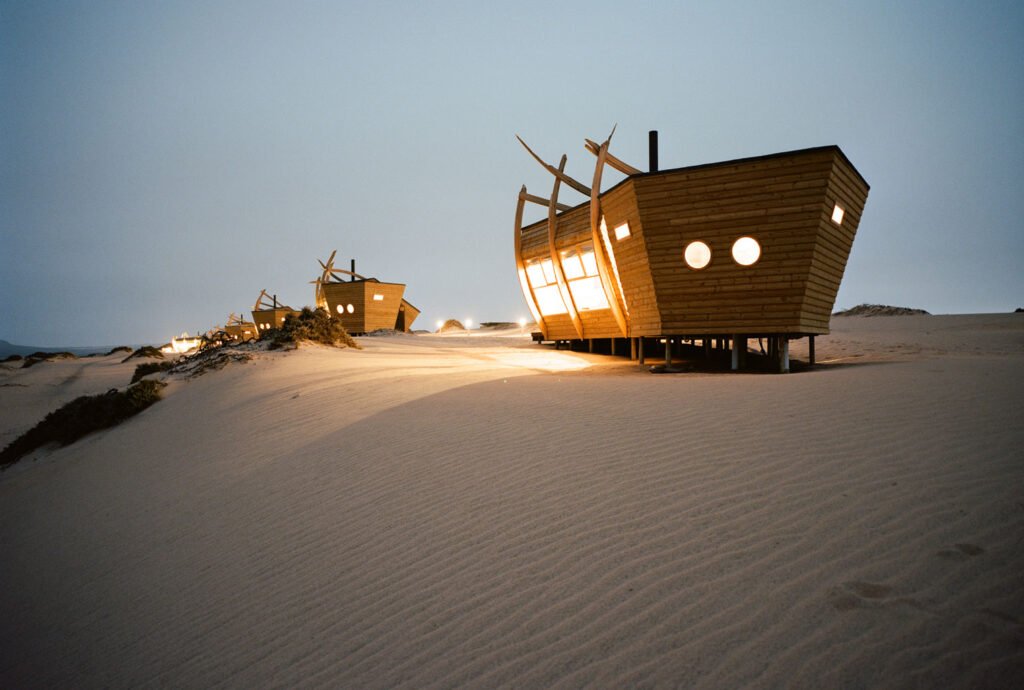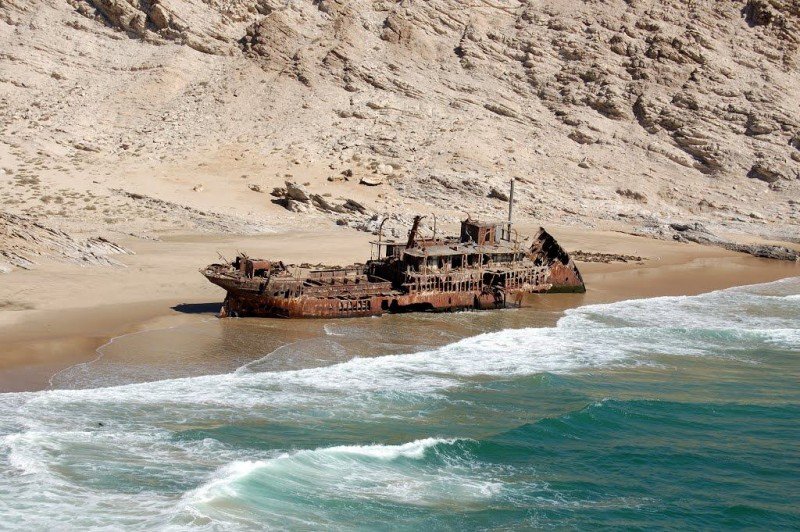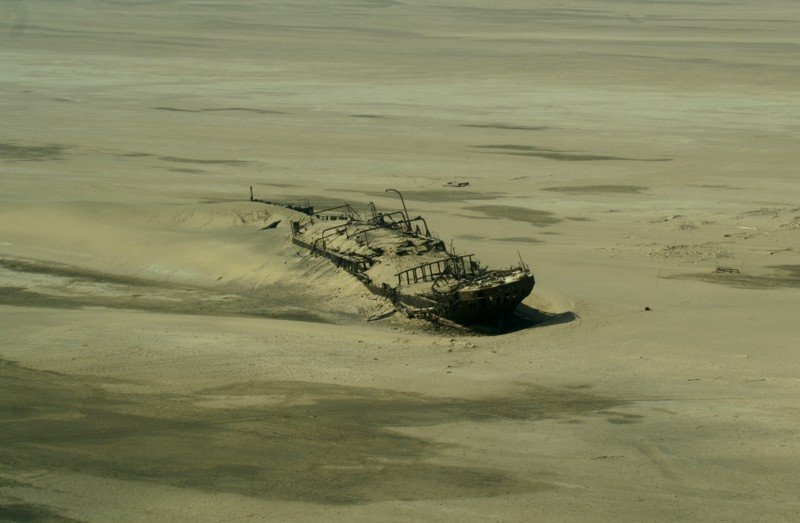The Skeleton Coast is the northern part of the Atlantic coast of Namibia. Immediately south of Angola, it stretches from the Kunene River to the Swakop River, although the name is sometimes used to describe the entire Namib Desert coast. The indigenous San people (formerly known as Bushmen), of the Namibian interior called the region “The Land God Made in Anger”, while Portuguese sailors once referred to it as “The Gates of Hell”.
On the coast, the upwelling of the cold Benguela current gives rise to dense ocean fogs (called cassimbo by the Angolans) for much of the year. The winds blow from land to sea, rainfall rarely exceeds 10 millimetres (0.39 inches) annually, and the climate is highly inhospitable. There is a constant, heavy surf on the beaches. In the days before engine-powered ships and boats, it was possible to get ashore through the surf, but impossible to launch from the shore. The only way out was by going through a marsh hundreds of kilometres long and only accessible via a hot and arid desert. The coast is largely made up of soft sand occasionally interrupted by rocky outcrops. The southern section consists of gravel plains, while north of Terrace Bay the landscape is dominated by high sand dunes. Skeleton Bay is also known as a great location for surfing.

Namibia’s Skeleton Coast is one of Africa’s lesser-known but very valuable gems. This remote and desolate region is home to spectacular scenery, consisting of sweeping vistas of deserts, ocean and sky, as well as a few hidden surprises.
Much of the coast falls under the protection of the Skeleton Coast National Park, with more flora and fauna thriving here than you’d think possible. Game drives in the region often deliver exciting sightings of Namibia wildlife– making Skeleton Coast Namibia’s most mind-boggling safari destination.
There are only a handful of exclusive lodges in Skeleton Coast National Park, affording the intrepid safari traveller a safe, comfortable and luxurious base from which to experience this extraordinary destination. Explore the coastline and its hinterland – dunes, ephemeral river valleys and patches of woodland – by 4X4 or on foot.
Why it is called The Skeleton Coast?
The Skeleton Coast in Namibia gets its striking name from the shipwrecks and the remains of whale and seal bones that litter the shoreline, from the beaches north of Swakopmund all the way to the Angolan border. The coast has long been a graveyard for shipwrecked sailors whose vessels fell victim to the Atlantic’s treacherous currents, shifting sandbanks and thick fog. The dangers of this deadly coastline also earned it the moniker “The Land God Made in Anger” by indigenous San people.

The exact Skeleton Coast location is in the northwestern region of Namibia. Approximately 40 kilometres (25 miles) wide and 500 kilometres (311 miles) long, the stretch of coastline runs alongside the Atlantic Ocean and reaches from the Kunene River down to the Swakop River. It also forms part of the larger Skeleton Coast National Park, a vast expanse of land that takes up over 16,000 square kilometres (6,178 square miles).
Why you should visit the Skeleton Coast?
See Maritime Shipwrecks & Marine Remains
Skeleton Coast’s shipwrecks and skeletal remains are not only the inspiration for the region’s name but also its biggest attraction. The golden beaches of this notorious coastline make up the world’s largest ship cemetery dotted with the remnants of the unlucky vessels that tangled with and lost against the cold and unpredictable Benguela Current of the Atlantic Ocean. The rusted debris is not the only relics of the sea found on Skeleton Coast. Bleached bones of marine animals (whales and seals in particular) litter the coastline, partly due to the whaling industry that once existed nearby.
The dramatic scenery of Skeleton Coast evokes a sense of mystery and history whose eerie allure compels you to explore the coastline.
Spot the Unique Skeleton Coast Wildlife

Despite the harsh environment, the animal populations that make up the Skeleton Coast wildlife are varied and thriving. Bird watchers on a Skeleton Coast safari will be pleasantly surprised by the nearly 250 species in the area while black-backed jackals are among the most seen animals. Hardy antelope species such as gemsbok, kudu and springbok can be seen at freshwater seeps and are sometimes joined by the mega-sightings of the region – desert-adapted elephants and giraffes. And if your luck is in, you might even get to see lions in Skeleton Coast.
The most dramatic wildlife spectacle is in the south of the Skeleton Coast National Park and in the National West Coast Recreational Area. The icy Atlantic is hugely fertile and supports an enormous colony of between 80,000 and 100,000 Cape fur seals at Cape Cross, about 130 kilometres (81 miles) north of Swakopmund. The noise and smell are often overpowering, not least during the November – December breeding season when as many as 200,000 seals gather on the shore. Predators such as brown hyena and black-backed jackal lurk on the periphery to take advantage of any opportunities.
Indulge in Adventure & Solitude
One of the best reasons to visit Skeleton Coast is undoubtedly the privacy and exclusivity you’ll enjoy during your stay. This hidden gem sees little foot traffic and is one of the most remote places in the world, ensuring unparalleled solitude and immersion in nature. And with few
Beyond the peace and tranquility, adventure is also on offer. The Skeleton Coast activities available are exciting and varied, from thrilling game drives in a 4×4 and hiking to the top of towering sand dunes to scenic flights over the coast and quad biking through the unique desert landscape.
For those who prefer a slower pace, take your time exploring the many shipwrecks scattered along the coast, visit the Himba communities and learn about their traditional lifestyle, or spend an afternoon deep-sea fishing before visiting the Cape Cross Seal Reserve to see thousands of Cape fur seals play in the water.

Learn About Namibia’s Rich Cultural History
Namibia’s Skeleton Coast not only offers an abundance of natural wonders but also holds a wealth of cultural significance. The northern region of Skeleton Coast is home to the Himba people, one of Namibia’s indigenous groups who are semi-nomadic pastoralists. A Skeleton Coast safari affords the rare opportunity to visit a Himba village and learn about their unique way of life, traditional customs, and how they’ve managed to adapt to the harsh desert environment and thrive for centuries.
So are you not visiting the Skeleton Coast in Namibia? if you are… then I know you are going to enjoy a wonderful experience… And if not yet, then pls add it to your bucket list of travel destinations this year…




